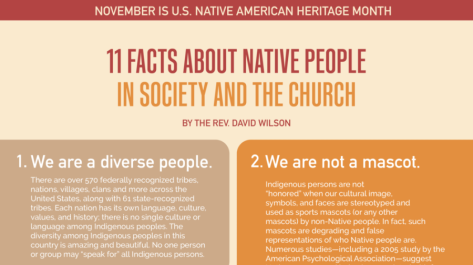11 Facts about Native People

NOVEMBER IS U.S. NATIVE AMERICAN HERITAGE MONTH
The following is excerpted from an online resource offered by R-Squared, a project of the General Commission on Religion and Race, and written by The Rev. David Wilson.
11 Facts about Native People in Society and the Church
1. We are a diverse people. There are over 570 federally recognized tribes across the United States, along with 61 state-recognized tribes.
2. We are not a mascot. Such mascots are degrading and false representations of who Native people are.
3. There are many names for Indigenous peoples in the United States and around the world. There is no specific term that is suitable for all.
4. Not all U.S. Native/Indigenous persons live on reservations. Less than 30 percent of all American Indians and Alaska Natives live on reservations.
5. Our regalia and dances have sacred and spiritual meaning. Wearing indigenous regalia as costumes is cultural appropriation.
6. Native Americans serve in the U.S. military at the highest rate of any ethnic group. Native veterans have served with distinction in every major conflict for over 200 years.
7. Native Americans as United Methodist leaders date back to the early 19th century. The first Native American District Superintendent was the Rev. Samuel Checote, a Muscogee, who was appointed in 1868 after he was relocated to Indian Territory in the 1820s.
8. Indigenous persons have made significant contributions to the world’s culture. The constitution of the Haudenosaunee Confederacy was used as a model for the Articles of Confederation, later incorporated into the U.S. Constitution.
9. Indigenous persons play a vital and important role in the life of The United Methodist church. There are 157 Native American United Methodist congregations in the U.S.
10. Tipis are not the typical housing for modern U.S. Indigenous people. Today, tipis are used mostly in ceremonies and cultural gatherings, and the majority of tribal people have never lived in tipis.
11. Indigenous persons are the only racial-ethnic group that must constantly “prove” who we are. To gain U.S. federal-government recognition and protection, Native Americans must document their racial identity.
For the full article and many more resources, visit www.r2hub.org.
